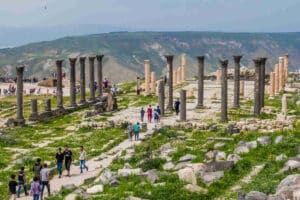As you can see in our Circuits, the most common thing is to head south from Amman, after having visited this city and making an excursion through the north of the country. However, it is also possible to head east and travel to the imposing desert that stretches before reaching the border with Saudi Arabia and Iraq. In this post we give you some reasons to travel to the Eastern Desert of Jordan, and you will see that there is something for everyone: nature, ethnography, history…
The Amazing and Historic Castles of the Desert
Undoubtedly, one of the great attractions of entering the Eastern Desert of Jordan is discovering its desert castles, which are scattered throughout the area. Actually, not all of them are defensive military structures, but there are also historic buildings that functioned as caravansares (inns or inns for merchants) and hunting lodges. The most important are Qasr Al Azraq (which served as the home of T.E. Lawrence), Qusayr Amra (with decorations from 18th-century wall paintings) and Qasr Kharana. But there are many more, which shows the strategic importance of this area during the Middle Ages.
Desert of different colors
Of course, these desert castles were not built randomly: they were located here because in the past the landscape was very different from today, as it was a fertile land with an abundance of water and trees. And above all, it was a very popular transport route. The progressive drought and desertification that this area has experienced over the centuries has taken all of this away, but it has left us with another landscape that is also of great interest to nature lovers: the purest desert. The Burqu Nature Reserve, where there is no shortage of a castle and ecotourism centres, is the best example of this.
And luckily for travelers to Jordan, it offers colors different from the usual golds and reds that predominate in the center and south of the country, such as in Wadi Rum. Here, most of the area is tinged with dark tones by the black volcanic rock, which extends over this immense inhospitable plain that offers us a lunar picture. And those who decide to continue southeast almost to the Saudi border, will reach Wadi al Dahik, where the rock turns white and the relief becomes irregular with canyons.
Nature that resists
Despite the conditions of extreme aridity that exist today, nature continues to resist in different ways. And contemplating it is an attraction in itself. The best example of this is the Azraq oasis, which is a wetland of high ecological value, especially due to the presence of migratory birds. It is precisely for this reason that it has been declared a Ramsar Site. On the other hand, the nearby Shaumari Nature Reserve is home to populations of native animals that, in some cases, are in danger of extinction or have been until recently. Undoubtedly, the most symbolic is the oryx (Oryx leucoryx), which can be sighted on organized safaris.
Living with local people
And of course, another attraction of traveling to the Eastern Desert of Jordan is living with the local population, especially with members of Bedouin communities, who continue to maintain some traditions of their ancestral nomadic life and are an example of adaptation to the environment. All of this is promoted and/or coordinated with Burqu Ecolodge, a centre that emerged on the initiative of the Royal Society for the Conservation of Nature which, in a way, serves as a visitor reception centre.



